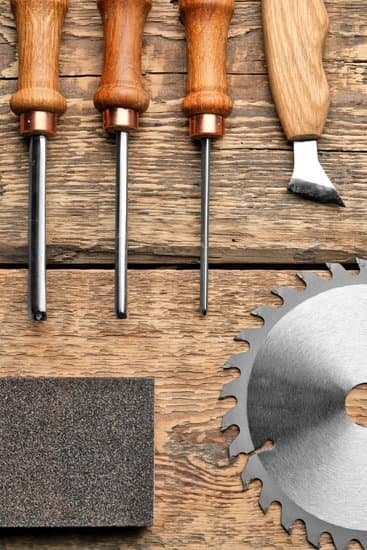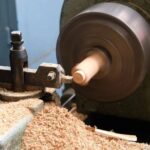Woodworking is a craft that has been around for centuries, allowing individuals to create functional and decorative pieces from wood. In the world of woodworking, there are various tools and equipment that are used to shape and form the wood into desired designs. One such tool is a shaper, which plays a significant role in shaping wood and enhancing the overall precision of woodworking projects.
A shaper in woodworking is a powerful machine that is specifically designed to cut, shape, and mold wood. It functions similarly to a router or a table saw but offers unique features and capabilities that make it an essential tool in any woodworker’s arsenal. The shaper allows woodworkers to create intricate profiles, edges, and joints with precision and ease.
The significance of a shaper in woodworking cannot be overstated. It enables woodworkers to produce consistent cuts and shapes even on complex or curved surfaces, ensuring high-quality craftsmanship.
With its versatility and accuracy, a shaper can tackle a wide range of woodworking tasks, from creating door panels, moldings, and furniture parts to crafting custom cabinets and trim work. Whether you’re a professional woodworker or an enthusiastic hobbyist, understanding the basics of woodworking and the importance of using a shaper will greatly enhance your ability to create stunning pieces with finesse.
Definition and Purpose
A shaper is a woodworking tool that is specifically designed for shaping and molding wood. It is often confused with a router or a table saw, but it has its own unique features and functions that make it an essential tool in the craft of woodworking.
The main purpose of a shaper is to create various profiles and shapes on the edges of wood pieces. It can be used to shape decorative moldings, panels, frames, as well as create joints such as tenons and grooves. Unlike routers, which are handheld tools, shapers are stationary machines that are typically mounted on a workbench or table.
One of the key components of a shaper is the spindle, which holds the cutting tool or cutter head. The spindle can rotate at different speeds, allowing woodworkers to achieve different cutting depths and feed rates. Shapers also have fences or guides that help in controlling the movement of the wood piece during shaping. Additionally, many modern shapers come with adjustable tables that allow for precise shaping and accurate cuts.
When it comes to woodworking, precision and accuracy are crucial. This is where a shaper shines compared to other tools like routers or table saws. Shapers offer greater control over the shaping process due to their stability and heavy-duty construction. They produce clean and even cuts without any chatter or tear-out on the wood surface.
In addition to this, shapers have interchangeable cutters and can accommodate various profiles and sizes, making them highly versatile tools for creating intricate designs. The ability to shape both long pieces of stock as well as small workpieces adds further flexibility to their usage.
Mechanics of a Woodworking Shaper
A woodworking shaper is a versatile tool used in woodworking to shape and mold wood according to the desired design. It consists of various components and features that work together to achieve precise and intricate cuts. Understanding the mechanics of a woodworking shaper is essential for woodworkers to fully utilize this tool’s capabilities and achieve desired results.
The main components of a woodworking shaper include the motor, cutterhead, fence, table, and feed system. The motor powers the cutterhead, which holds the cutting tools such as knives or router bits. The fence acts as a guide for the wood being shaped, ensuring accuracy and consistency in shaping profiles. The table provides support for the wood during operation.
Some shapers also come with interchangeable spindles or arbors that allow for different diameters and types of cutting tools to be used. This feature enhances the versatility of the shaper, enabling woodworkers to create a wide range of profiles and decorative elements on their projects.
Another important feature of a woodworking shaper is its feed system. This can vary depending on the model but often includes feed rollers or belts that securely grip the wood being shaped and move it past the cutterhead at a consistent rate. This ensures smooth and controlled feeding of the wood, resulting in accurate shaping.
Understanding these various components and features of a woodworking shaper is crucial for woodworkers to effectively operate this tool. By familiarizing themselves with how each component works together, they can maximize its potential in creating intricate designs and achieving desired results in their woodworking projects.
| Component | Description |
|---|---|
| Motor | Powers the cutterhead. |
| Cutterhead | Holds cutting tools such as knives or router bits. |
| Fence | Acts as a guide for the wood being shaped. |
| Table | Provides support for the wood during operation. |
| Feed System | Moves the wood past the cutterhead at a consistent rate. |
Different Types of Shapers Available in the Market
Woodworking shapers come in various types, each designed for specific applications. Understanding the different types of shapers available in the market can help woodworkers choose the most suitable one for their projects. Here are some common types of shapers and their specific applications:
- Spindle Shaper: This type of shaper features a vertical spindle that holds various cutter heads. It is commonly used for shaping edges and profiles on long pieces of wood, such as moldings, rails, and stiles. The cutter heads can be changed to achieve different profiles, allowing for versatility in shaping options.
- Sliding Table Shaper: This type of shaper has a sliding table that moves back and forth, allowing woodworkers to feed the stock against the spinning cutter head from different angles. Sliding table shapers are typically used for tenoning, grooving, and edge profiling tasks.
- Tilting Spindle Shaper: As the name suggests, this type of shaper allows the spindle to tilt at an angle, usually up to 45 degrees. This feature enables the woodworker to create angled cuts and complex profiles on the workpiece.
- Power Feeder Shaper: Power feeder shapers have a power feed attachment that automatically feeds the stock into the cutter head at a consistent rate. This helps ensure smooth and consistent cuts, especially when working with large volumes or wide boards.
- Combination Shaper: Combination shapers combine features from multiple types of shapers into one machine. For example, a combination shaper may have a tilting spindle as well as a sliding table function. These versatile machines offer greater flexibility in performing various woodworking tasks.
It is important to research and understand the specific capabilities and limitations of each type of shaper before making a purchase. Consider factors such as the size of your projects, desired cutting angles, and complexity of profiles needed to determine which type of shaper will best suit your woodworking needs.
Benefits of Using a Shaper in Woodworking
There are several benefits to using a shaper in woodworking that make it a valuable tool for craftsmen. This section will highlight the advantages and unique abilities of shapers in comparison to other tools such as routers and table saws.
One of the major benefits of using a shaper is its versatility. Shapers can be used for a wide range of woodworking tasks including shaping, molding, and cutting various types of wood. Unlike routers which are primarily used for edging and trimming, shapers have larger work surfaces and powerful motors, allowing them to handle larger stock and perform more complex operations.
Another advantage of using a shaper is its precision and accuracy. Shapers are designed with adjustable fences, guides, and depth controls that ensure precise cuts and consistent results. The ability to make intricate cuts, create decorative moldings, and shape curved profiles with ease sets the shaper apart from other tools in terms of precision.
In addition to versatility and precision, another benefit of using a shaper is its efficiency. Shapers are equipped with high-speed rotating spindles or cutter heads that can remove material quickly and efficiently. This makes them ideal for large-scale production tasks where time is crucial.
Overall, the unique abilities offered by a shaper make it an excellent tool choice for serious woodworkers who require precision, versatility, and efficiency in their craft. Whether it’s creating custom moldings or shaping intricate profiles, the use of a shaper can greatly enhance the quality and efficiency of woodworking projects.
A Step-by-Step Guide to Using a Shaper
Woodworking can be an incredibly rewarding craft, allowing individuals to unleash their creativity and create beautiful pieces using different techniques and tools. One such tool that is essential in woodworking is a shaper. In this section, we will provide a step-by-step guide on how to use a shaper effectively for various woodworking tasks.
Step 1: Safety Precautions
Before starting any woodworking task, it is crucial to prioritize safety. Always wear appropriate protective gear such as safety glasses, earplugs or earmuffs, and a dust mask. It is also important to secure the workpiece properly using clamps or jigs to prevent it from moving during operation.
Step 2: Set Up the Shaper
First, ensure that the shaper is securely positioned on a stable work surface. Adjust the height of the cutter head according to your desired depth of cut. Next, select the appropriate cutter for your woodworking task based on factors such as shape, size, and type of cut you want to achieve.
Step 3: Feed Direction
When feeding the material into the shaper, always feed it against the rotation of the cutterhead for optimal results. Pushing wood with grain direction offers smoother cuts while pushing against grain direction provides better control but may leave rougher surfaces.
Step 4: Guiding Techniques
To guide your material through the shaper safely and accurately, use fence guides or featherboards to ensure straight lines and consistent measurements. These accessories help maintain control over your workpiece and reduce the risk of accidents.
Step 5: Operation Techniques
Start by making light passes at first until you become comfortable with using the shaper. Gradually increase the depth of cut as needed, taking care not to remove too much material in a single pass, which could strain the cutting head or affect the quality of the cut.
Step 6: Finishing Touches
Once you have completed your desired cut or shaping operation, turn off and unplug the shaper. Allow any remaining cutterhead momentum to come to a complete stop before removing your workpiece from the machine.
By following these step-by-step instructions, woodworkers can effectively set up and operate a shaper for various woodworking tasks. Remember to always prioritize safety and take your time to ensure accurate results. With practice and experience, using a shaper will become second nature, allowing you to unlock its full potential in your craft.
Shaper Safety Measures
When working with a shaper in woodworking, safety should always be a top priority. The powerful nature of the machine and the potential risks involved make it crucial for woodworkers to take proper safety measures. By following essential guidelines for accident prevention, woodworkers can minimize the risk of injury and ensure a safe working environment.
Understanding Potential Hazards
It is important to be aware of the potential hazards associated with using a shaper. One of the primary dangers is the rotating cutter head, which can cause serious injuries if not handled properly. The cutting edges are sharp and can easily catch loose clothing or jewelry, leading to severe lacerations or even amputation.
Another hazard is kickback, which occurs when the wood being shaped is propelled back towards the operator at high speed. This can happen if improper feeding techniques are used or if inadequate hold-downs and guards are in place. In addition, flying chips and debris pose a risk to eyesight, making eye protection an absolute necessity.
Essential Safety Guidelines
To ensure safe operation of a shaper, it is essential to adhere to specific safety guidelines:
- Wear appropriate personal protective equipment (PPE) such as safety glasses or goggles, ear protection, gloves, and non-slip footwear.
- Familiarize yourself with the shaper’s manual before operation. Understand all warnings and instructions provided by the manufacturer.
- Ensure that the workspace is well-lit and organized. Keep it free from distractions to maintain focus while operating the shaper.
- Always use proper feeding techniques when working with stock material. Maintain a consistent feed rate while applying adequate pressure to prevent kickback.
- Never reach over or near the cutter when it is running. Allow sufficient time for it to come to a complete stop before making any adjustments or inspections.
- Use hold-downs, featherboards, and other appropriate devices to secure the workpiece and prevent it from moving during shaping.
- Routinely inspect the shaper for any damage or signs of wear that may affect its safe operation. Replace worn-out parts and maintain the machine in good working condition.
By following these safety measures, woodworkers can significantly reduce the risk of accidents and injuries when using a shaper in woodworking. It is essential to prioritize safety at all times and continuously educate oneself on proper operating procedures to ensure a safe and productive woodworking experience.
Essential Accessories and Attachments for Shapers
A woodworking shaper is a versatile and powerful tool that can be enhanced even further with the use of essential accessories and attachments. These additional tools and equipment not only enhance the functionality of the shaper but also increase its versatility, allowing woodworkers to tackle a wider range of projects.
One essential accessory for a woodworking shaper is the featherboard. A featherboard is a device that holds the wood against the fence or table during cutting, preventing it from moving or shifting. This not only ensures safety but also helps in achieving clean and accurate cuts. Featherboards come in various types, including single and double featherboards, and can be easily attached to the shaper using adjustable clamps.
Another useful attachment for a shaper is a sliding table. A sliding table allows for smoother and more precise feeding of workpieces into the shaper while providing support throughout the cut. This attachment is particularly helpful when working with larger or heavier materials that may be difficult to maneuver on a regular tabletop.
In addition to these accessories, it is also beneficial to have a wide variety of cutter heads and router bits for different woodworking tasks. These tools allow woodworkers to achieve various profiles, shapes, and designs on their workpieces. Some common types of cutter heads used with shapers include stile and rail sets, panel raising bits, edge forming bits, and molding heads.
These essential accessories and attachments greatly enhance the functionality and versatility of a shaper, allowing woodworkers to tackle a wide range of projects with ease. Whether it’s achieving clean cuts with the help of featherboards or working on intricate designs using specialized cutter heads, these tools are invaluable additions to any woodworking shop.
| Essential Accessories | Attachments |
|---|---|
| Featherboard | Sliding Table |
| Cutter Heads | Router Bits |
Comparing Shapers and Other Woodworking Tools
Woodworking involves a variety of tools that are used for different purposes, and two popular tools that are often compared to shapers are routers and table saws. While all three tools can be used in woodworking projects, there are distinct differences and benefits that shapers offer in comparison.
One key difference between shapers and routers is the direction of the cut. Shapers are designed to cut with the grain of the wood, while routers typically cut across or against the grain. This means that shapers are better suited for tasks such as creating decorative moldings, shaping edges, and profiling panels. On the other hand, routers excel at tasks like cutting joinery, creating dadoes and rabbets, and trimming edges.
Another significant difference is the versatility and precision offered by shapers. Shapers typically have a larger work surface known as a table, which allows for greater stability when working with larger pieces or performing intricate cuts. Additionally, shapers often come with adjustable fences and guides that provide enhanced accuracy and control during shaping operations. Routers, while versatile in their own right, may not provide the same level of stability or precision as shapers due to their smaller size.
Table saws, on the other hand, excel at ripping boards and making straight cuts. They are commonly used for tasks such as cross-cutting, mitering, beveling, and creating dados. Table saws offer speed and efficiency for these types of cuts but may not be as suitable for shaping or profiling work where precision or intricate detail is required.
In summary, while routers and table saws have their own strengths in woodworking projects, shapers offer unique benefits when it comes to shaping operations using large pieces of wood or achieving precise profiles. Woodworkers should consider their specific project needs when choosing between these tools in order to achieve the desired results efficiently and accurately.
| Shaper | Router | Table Saw |
|---|---|---|
| Cuts with the grain of the wood | Tends to cut across or against the grain | Primarily used for ripping boards and making straight cuts |
| Offers stability and precision with a larger work surface and adjustable fences/guides | Versatile but may not provide the same level of stability or precision as shapers due to their smaller size | Efficient for certain cuts but may lack precision or intricate detail capabilities |
| Ideal for shaping operations and creating decorative moldings, profiling panels, etc. | Well-suited for cutting joinery and trimming edges | Excellent for cross-cutting, mitering, beveling, creating dados, etc. |
Recommended Shaper Brands and Models
In the world of woodworking, having the right tools is essential to achieving quality results. When it comes to shapers, there are several trusted and high-quality brands that woodworkers can rely on. These brands have a reputation for manufacturing durable and efficient shapers that cater to different woodworking needs. Here are some recommended shaper brands and models for woodworkers to consider.
Powermatic
One of the top names in the woodworking industry, Powermatic offers a range of high-quality shapers that are known for their precision and durability. Their shapers are designed with advanced features such as variable speed control, adjustable fences, and easy-to-use controls, allowing woodworkers to achieve precise cuts and shapes with ease. Powermatic shapers are also known for their sturdy construction and reliability, making them a favorite among professionals.
Grizzly
Grizzly is another reputable brand in the woodworking community that offers a wide selection of quality shapers. Their shaper models range from compact benchtop units to heavy-duty floor-standing machines, accommodating different workshop sizes and needs. Grizzly shapers are known for their affordability without compromising on performance and durability. They feature powerful motors, adjustable spindles, and user-friendly controls, making them suitable for both beginners and experienced woodworkers.
Delta
Delta is a well-established brand when it comes to woodworking machinery, including shapers. With a long history of producing reliable tools, Delta has earned the trust of many woodworkers worldwide. Delta’s shaper models are known for their precision cutting capabilities and versatile features. They offer various spindle options, adjustable fences, and smooth operation for enhanced accuracy and ease of use.
Jet
Jet is a brand renowned for its commitment to delivering high-performance woodworking machinery, including top-notch shapers. Jet offers an impressive range of shaper models suitable for various woodworking applications. Their shapers are known for their robust construction, powerful motors, and convenient features such as tilting spindles and belt drive systems. Jet shapers provide woodworkers with the precision and control needed to create intricate shapes and profiles.
Overall, these recommended shaper brands have proven themselves in the industry by consistently delivering durable, efficient, and versatile shapers that meet the demands of professional woodworkers. When selecting a shaper, it is important to consider factors such as your specific woodworking needs, budget, and available space in your workshop. By investing in a reputable brand and model that suits your requirements, you can ensure smooth operations, precise results, and a tool that will serve you well for years to come.
Conclusion
In conclusion, understanding the basics of woodworking and the significance of a shaper is essential for any woodworker. A shaper is a powerful tool that plays a crucial role in shaping and molding wood to create intricate designs and professional finishes. It is important for woodworkers to be familiar with the definition and purpose of a shaper, as well as its various components and features.
One of the key benefits of using a shaper in woodworking is its unique abilities compared to other tools. Shapers not only provide precision and accuracy, but they also allow for versatility in creating different types of profiles and cuts. This makes them indispensable for tasks such as furniture making, cabinetry, and decorative woodworking.
While using a shaper may seem daunting at first, following a step-by-step guide can help woodworkers set up and operate it effectively. Additionally, it is crucial to prioritize safety when using a shaper by adhering to essential guidelines for accident prevention. Wearing protective gear, maintaining proper equipment maintenance, and ensuring workspace organization are all integral aspects of working with this powerful tool.
In comparison to similar tools like routers and table saws, shapers offer distinct advantages that make them highly sought after by professional woodworkers. Their ability to produce smooth edges, intricate details, and consistent results sets them apart from other tools in terms of quality craftsmanship.
For those interested in incorporating a shaper into their woodworking arsenal, it is advisable to consider reputable brands that offer high-quality models. Conducting thorough research on recommended brands will ensure that woodworkers invest wisely in durable equipment that will stand the test of time.
Frequently Asked Questions
Is a shaper the same as a router?
No, a shaper is not the same as a router. While both tools are used for shaping and cutting wood, they have distinct differences. One major difference lies in their designs. A shaper typically consists of a power-driven spindle with cutters, whereas a router has a handheld motor with a collet that holds the cutting bit.
Additionally, shapers are generally larger and more powerful machines compared to routers. Shapers often have larger worktables and can accommodate bigger and more complex woodworking projects. On the other hand, routers offer greater flexibility due to their portability and hand-held operation, making them suitable for smaller scale tasks.
What is the difference between a shaper and a jointer?
The main difference between a shaper and a jointer lies in their primary functions in woodworking. A shaper is primarily used for shaping wood by creating various profiles such as edges, moldings, or raised panels. It achieves this through the rotation of cutters mounted on its spindle assembly.
In contrast, a jointer is specifically designed to flatten and straighten one face of a piece of rough lumber while simultaneously creating a square edge on another face. This process enables improved accuracy when joining pieces together to create flat surfaces or precise angles during woodworking projects.
What are shapers used for?
Shapers are primarily used in woodworking for shaping wood pieces into various desired profiles or forms. With their robust design and powerful motors, they excel at creating decorative edges, moldings, grooves, slots, and even intricate details like raised panels or flutes on wood surfaces.
Shapers can handle both large-scale production work in industrial settings as well as intricate custom projects in smaller workshops or cabinet-making applications. They are known for their versatility when it comes to shaping different types of wood species and sizes, providing precision and repeatability required by professionals working on furniture-making, cabinetry, millwork, or architectural woodworking projects.

Hi everyone! I’m a woodworker and blogger, and this is my woodworking blog. In my blog, I share tips and tricks for woodworkers of all skill levels, as well as project ideas that you can try yourself.





